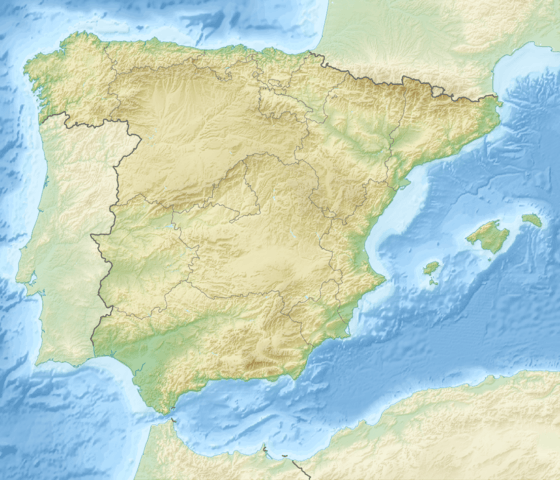Alcántara Bridge
| Alcántara Bridge | |
|---|---|
|
| |
| Coordinates | 39°43′21″N 6°53′33″W / 39.7224°N 6.8924°WCoordinates: 39°43′21″N 6°53′33″W / 39.7224°N 6.8924°W |
| Crosses | Tagus River |
| Locale | Alcántara, Spain |
| Heritage status | Listed as cultural heritage since 1921[1] |
| Characteristics | |
| Design | Roman arch bridge |
| Material | Stone |
| Total length | 181.7 m[2] |
| Width | 8.6 m[2] |
| Height | 45 m[3] |
| Longest span | 28.8 m[4] |
| Number of spans | 6 |
| Load limit | 52 t[5] |
| History | |
| Designer | Caius Julius Lacer |
| Construction begin | 104 AD |
| Construction end | 106 AD |
 Alcántara Bridge Location in Spain | |
The Alcántara Bridge (also known as Trajan's Bridge at Alcantara) is a Roman stone arch bridge built over the Tagus River at Alcántara, in Extremadura, Spain, between 104 and 106 AD by an order of the Roman emperor Trajan in 98.[6]
History


The Alcántara Bridge has suffered even more damage from war than from the elements over the years. The Moors destroyed one of the smallest arches in 1214 although this was rebuilt centuries later, in 1543, with stone taken from the original quarries. The second arch on the northwest side was then later destroyed in 1760 by the Spanish to stop the Portuguese advancing and was repaired in 1762 by Charles III, only to be blown up again in 1809 by Wellington's forces attempting to stop the French. Temporary repairs were made in 1819, but much of the bridge was destroyed yet again in 1836 by the Carlists. The bridge was rebuilt in 1860 using mortared masonry.[6] And following completion of the José María de Oriol Dam, which allowed for the draining of the Tagus riverbed, the main pillars were completely repaired in 1969.
The bridge originally measured 190 m in length, which is today reduced to 181.7 m.[2] The clear spans of the six arches from the right to the left riverside are 13.6, 23.4, 28.8, 27.4, 21.9 and 13.8 m.[4]
It bears the following inscription on the archway over the central pier.[6]
| Original | Translation |
|---|---|
| Pontem perpetui mansurum |
Permanent bridge will remain |
Gallery
-

Looking south, in the background the small temple with Lacers grave
-
The entrance of the temple with the Grablege of the Roman architect
See also
References
- ↑ Patrimonio histórico: Bienes culturales protegidos. Consulta de bienes inmuebles. Bien: "Puente de Alcántara", retrieved 13-01-2010 (Spanish)
- 1 2 3 Galliazzo 1994, p. 354
- ↑ From river bed to deck, excluding the triumphal arch (Galliazzo 1994, pp. 354f.). O'Connor 1993, p. 109 gives 48 m, 40–42 m for the height above the water level plus 14 m for the triumphal arch.
- 1 2 Galliazzo 1994, p. 356
- ↑ Durán Fuentes 2004, p. 237
- 1 2 3 Whitney, Charles S. (2003) [1929], Bridges of the World: Their Design and Construction, Mineola, New York: Dover Publications, pp. 75–79, ISBN 0-486-42995-4
Further reading
- Brown, David J. (1993), Bridges, New York: Macmillan Publishing Company, p. 25, ISBN 0-02-517455-X
- Durán Fuentes, Manuel (2004), La Construcción de Puentes Romanos en Hispania, Santiago de Compostela: Xunta de Galicia, pp. 194–200, ISBN 978-84-453-3937-4
- Galliazzo, Vittorio (1994), I ponti romani. Catalogo generale, Vol. 2, Treviso: Edizioni Canova, pp. 353–358 (No. 754), ISBN 88-85066-66-6
- Graf, Bernhard (2002), Bridges that Changed the World, Munich: Prestel, pp. 20–21, ISBN 3-7913-2701-1
- O’Connor, Colin (1993), Roman Bridges, Cambridge University Press, pp. 109–111 (SP21), ISBN 0-521-39326-4
External links
| Wikimedia Commons has media related to Alcántara Bridge. |
- Alcantara Bridge at Structurae
- Puente de Alcántara sobre el Tajo, en Cáceres (Spanish)
- Video of the bridge
- Video of Alcántara